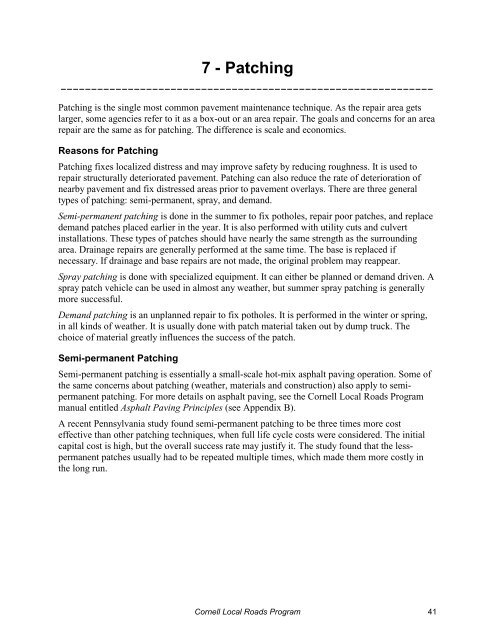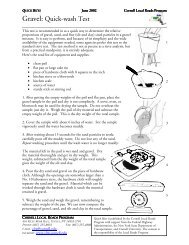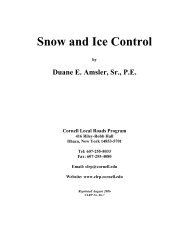Pavement Maintenance - Cornell Local Roads Program - Cornell ...
Pavement Maintenance - Cornell Local Roads Program - Cornell ...
Pavement Maintenance - Cornell Local Roads Program - Cornell ...
You also want an ePaper? Increase the reach of your titles
YUMPU automatically turns print PDFs into web optimized ePapers that Google loves.
7 - Patching<br />
_____________________________________________________________<br />
Patching is the single most common pavement maintenance technique. As the repair area gets<br />
larger, some agencies refer to it as a box-out or an area repair. The goals and concerns for an area<br />
repair are the same as for patching. The difference is scale and economics.<br />
Reasons for Patching<br />
Patching fixes localized distress and may improve safety by reducing roughness. It is used to<br />
repair structurally deteriorated pavement. Patching can also reduce the rate of deterioration of<br />
nearby pavement and fix distressed areas prior to pavement overlays. There are three general<br />
types of patching: semi-permanent, spray, and demand.<br />
Semi-permanent patching is done in the summer to fix potholes, repair poor patches, and replace<br />
demand patches placed earlier in the year. It is also performed with utility cuts and culvert<br />
installations. These types of patches should have nearly the same strength as the surrounding<br />
area. Drainage repairs are generally performed at the same time. The base is replaced if<br />
necessary. If drainage and base repairs are not made, the original problem may reappear.<br />
Spray patching is done with specialized equipment. It can either be planned or demand driven. A<br />
spray patch vehicle can be used in almost any weather, but summer spray patching is generally<br />
more successful.<br />
Demand patching is an unplanned repair to fix potholes. It is performed in the winter or spring,<br />
in all kinds of weather. It is usually done with patch material taken out by dump truck. The<br />
choice of material greatly influences the success of the patch.<br />
Semi-permanent Patching<br />
Semi-permanent patching is essentially a small-scale hot-mix asphalt paving operation. Some of<br />
the same concerns about patching (weather, materials and construction) also apply to semipermanent<br />
patching. For more details on asphalt paving, see the <strong>Cornell</strong> <strong>Local</strong> <strong>Roads</strong> <strong>Program</strong><br />
manual entitled Asphalt Paving Principles (see Appendix B).<br />
A recent Pennsylvania study found semi-permanent patching to be three times more cost<br />
effective than other patching techniques, when full life cycle costs were considered. The initial<br />
capital cost is high, but the overall success rate may justify it. The study found that the lesspermanent<br />
patches usually had to be repeated multiple times, which made them more costly in<br />
the long run.<br />
<strong>Cornell</strong> <strong>Local</strong> <strong>Roads</strong> <strong>Program</strong> 41





